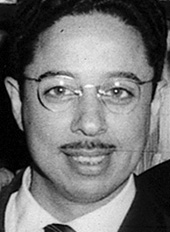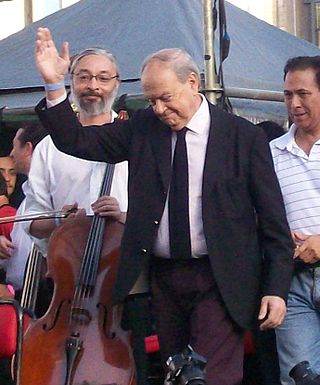
Astor Pantaleón Piazzolla was an Argentine tango composer, bandoneon player, and arranger. His works revolutionized the traditional tango into a new style termed nuevo tango, incorporating elements from jazz and classical music. A virtuoso bandoneonist, he regularly performed his own compositions with a variety of ensembles. In 1992, American music critic Stephen Holden described Piazzolla as "the world's foremost composer of Tango music".

Tango is a style of music in 2
4 or 4
4 time that originated among European and African immigrant populations of Argentina and Uruguay. It is traditionally played on a solo guitar, guitar duo, or an ensemble, known as the orquesta típica, which includes at least two violins, flute, piano, double bass, and at least two bandoneóns. Sometimes guitars and a clarinet join the ensemble. Tango may be purely instrumental or may include a vocalist. Tango music and dance have become popular throughout the world.

Francisco Canaro was a Uruguayan violinist and tango orchestra leader.

Julio María Sosa Venturini, usually referred to simply as Julio Sosa or El Varón del Tango, was a Uruguayan tango singer.

Horacio Lavandera is an Argentine pianist, currently residing in Madrid, Spain. As its youngest competitor at the age of sixteen, he won the International Piano Competition Umberto Micheli, held at the Giuseppe Verdi Conservatoire and in Teatro alla Scala in Milan. He has been invited to perform as a soloist with prestigious orchestras, as well as to offer recitals in America, Europe, and Asia.

Horacio Adolfo Salgán was an Argentine tango musician. He was born in Buenos Aires to an established Afro-Argentine family. Some of Salgán's most well-known compositions include Del 1 al 5 (1944), Don Agustín Bardi (1947), Entre tango y tango (1953), Grillito, La llamo silbando, Cortada de San Ignacio, and A fuego lento. He turned 100 in June 2016 and died two months later on August 19, 2016.
Homero Aldo Expósito was an Argentine poet and tango songwriter. He used to compose with his brother Virgilio Expósito, who was responsible for the music.
Ignacio Varchausky is a double bass player, music producer and founder of Orquesta El Arranque (1996). He is also the creator and artistic director of Orquesta Escuela de Tango Emilio Balcarce.
Orquesta El Arranque is an Argentine tango orchestra formed in Buenos Aires in 1996.

Antonio Agri was an Argentine violinist, composer and conductor prominent in both the tango and classical music genres.

The Buenos Aires Philharmonic is an Argentinian orchestra based in Buenos Aires. Founded in 1946, it is based in the renowned Teatro Colón, and is considered one of the most prestigious orchestras in its nation and Latin America, and has received several honours in 60 years of history. Their local counterparts in the national aegis are the Argentine National Symphony Orchestra and the Teatro Colón Orchestra. The orchestra's current Music Director is Mexican Enrique Diemecke.
José Bragato was an Italian-born Argentine cellist, composer, conductor, arranger and musical archivist who, in his early career, was principal cellist in the Colón Theatre orchestra in Buenos Aires, Argentina. Apart from his involvement in classical music he also performed for many years in a number of Ástor Piazzolla's Nuevo tango ensembles where his cello solos, which had never before featured in tango, put him in the vanguard of Nuevo tango from its birth in the 1950s. Since then he has done numerous and varied arrangements of Piazzolla's compositions.

Atilio Stampone was an Argentine pianist, composer, and arranger prominent in the Tango genre.
Elvino Vardaro was an Argentine tango composer and violinist.
Enrique Mario Francini was an Argentine tango orchestra director, composer and violinist who played in various tango ensembles including the Orquesta Francini-Pontier and Ástor Piazzolla's Octeto Buenos Aires.
Enrique Kicho Díaz was an Argentine double bass tango musician who played in various ensembles including Aníbal Troilo’s orquesta típica, Astor Piazzolla’s first Quinteto and Conjunto 9 and finally Sexteto Mayor.
Orquesta Francini-Pontier was an Orquesta típica formed in 1945 in Argentina by the violinist Enrique Mario Francini and the bandoneonist Armando Pontier. The orchestra played together until 1955 and was one of the leading tango orchestras of its day.
Miguel Ángel Gilardi is an orchestra conductor. He is the son of the Argentinian composer Gilardo Gilardi and María Lucrecia Madariaga.
Rodolfo Miguel Montironi is an Argentine bandoneonist, conductor, composer and arranger who has been involved in many tango orchestras in addition to his own.
Simón Bajour also Szymsia Bajour was a Jewish Polish-Argentine violinist who was known for both his popular and classical repertoires.









